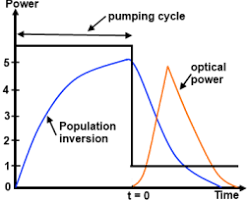
Q-switched lasers are essential for generating high-energy, short-pulse laser outputs in applications like laser machining, LIBS, and medical procedures. Selecting the right Q-switched laser—active or passive—requires understanding their operational principles and trade-offs. This article briefly explains passive vs active Q-switching lasers and outlines key considerations for choosing the best Q-switched laser, highlighting RPMC Lasers’ solutions for your needs.
Understanding Q-Switched Lasers
Q-switching produces high-energy pulses by temporarily increasing cavity losses to prevent lasing, allowing population inversion in the gain medium to build until saturation. When the Q-switch is “opened,” cavity losses drop, releasing stored energy in a rapid, high-peak-power pulse (100 ps to 10 ns). Active and passive Q-switching methods achieve this effect differently, each suited to specific applications based on cost, size, triggering, and pulse energy requirements.
Below, we explore the two main Q-switching approaches and key factors for selecting the right laser, with solutions from RPMC Lasers’ Active Q-Switch Lasers and Passive Q-Switch Lasers portfolios.
Passive vs. Active Q-Switch: Key Technologies
Q-switched lasers are categorized into active and passive types, each leveraging distinct mechanisms to control cavity losses and generate pulses.
Active Q-Switching: Precision Control for Pulsed Lasers
Active Q-switching uses external mechanisms, like acousto-optic or electro-optic modulators, to rapidly adjust cavity losses. For example, an acousto-optic modulator creates a grating when activated, deflecting spontaneously emitted photons out of the laser cavity to prevent lasing. When deactivated, it allows photons to pass, initiating stimulated emission and producing a high-energy pulse. This method offers precise control over pulse timing and repetition rates, ideal for applications requiring synchronization, such as laser-induced breakdown spectroscopy (LIBS) or kinematic laser machining.
Explore Active Q-Switch Solutions: Discover RPMC’s Active Q-Switch Lasers for customizable, high-precision pulsed laser systems tailored to your application. Contact us for expert guidance:
Passive Q-Switching: Compact and Cost-Effective Pulsing
Passive Q-switching relies on saturable absorption, where a material absorbs spontaneously emitted photons until its energy levels saturate, becoming temporarily transparent. This allows photons to pass through, triggering stimulated emission and a high-energy pulse. Passive Q-switches, like those in microchip lasers, require no external drivers, making them compact and cost-effective for applications where size and budget are priorities, such as portable laser systems.
Discover Passive Q-Switch Solutions: Explore RPMC’s Passive Q-Switch Lasers for compact, affordable pulsed laser options. Contact us to find the right fit:
Key Considerations for Choosing a Q-Switched Laser
Selecting the right Q-switched laser involves balancing performance, cost, and application requirements. Here are the primary factors to consider:
1. Cost Efficiency for Budget-Conscious Applications
Passive Q-switched lasers are generally more affordable due to their simpler design and lack of drive electronics. For cost-sensitive projects, such as portable or entry-level systems, passive solutions are ideal.
RPMC Solution: Our Passive Q-Switch Lasers offer cost-effective, high-performance options for budget-conscious applications without sacrificing reliability.
2. Compact Size for Space-Limited Systems
Passive Q-switches, often monolithically bonded to the laser crystal, enable ultra-compact designs, with cavity lengths as small as 1 mm. Active Q-switches, like Pockels cells, are larger (up to 10 cm), making them less suited for space-constrained setups.
RPMC Solution: RPMC’s Passive Q-Switch Lasers are perfect for microchip lasers and compact OEM integrations, ensuring high performance in minimal space.
3. Triggering and Synchronization for Precision Applications
Active Q-switching provides precise control over pulse timing, enabling synchronization with external devices like spectrometers or kinematic arms. Passive Q-switches lack this control, leading to potential pulse jitter, though internal photodiodes can aid synchronization.
RPMC Solution: Our Active Q-Switch Lasers deliver precise triggering for applications like LIBS and laser machining, ensuring seamless integration with your system.
4. Pulse Energy for High-Power Needs
Active Q-switches typically produce higher pulse energies (mJ levels) by allowing full population inversion before release. Passive Q-switches may release energy before maximum inversion, limiting pulse energy but still achieving significant outputs.
RPMC Solution: Choose Active Q-Switch Lasers for maximum pulse energy in demanding applications or Passive Q-Switch Lasers for balanced performance in compact systems.
Why Choose RPMC for Q-Switched Lasers?
Q-switched lasers are critical for applications requiring high-peak-power pulses, from industrial machining to medical and scientific research. RPMC Lasers offers a wide range of Active Q-Switch Lasers and Passive Q-Switch Lasers, providing tailored solutions for cost, size, triggering, and energy needs. Our expertise ensures you find the right laser for your project, backed by reliable performance and technical support.
Ready to Select Your Q-Switched Laser?
Choosing between active and passive Q-switched lasers depends on your application’s priorities. RPMC’s Active Q-Switch Lasers offer precision and high energy, while our Passive Q-Switch Lasers provide compact, cost-effective solutions. Contact our team at [email protected] or click below to explore your options.
Contact RPMC Lasers for Expert Guidance!

 BUY NOW
BUY NOW